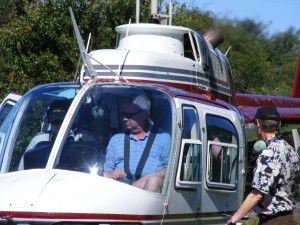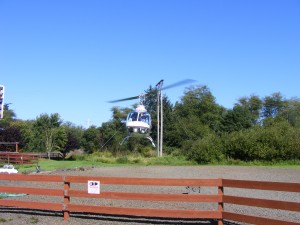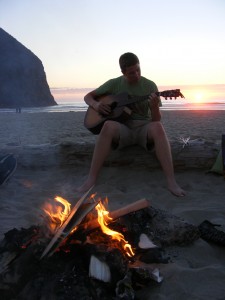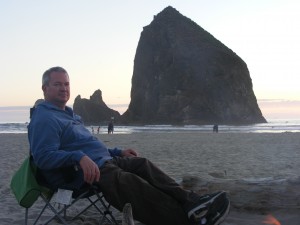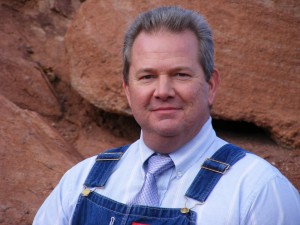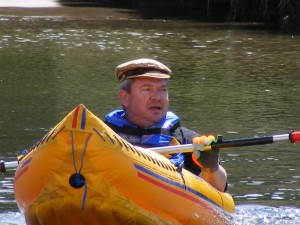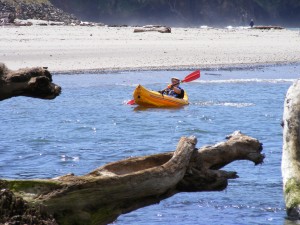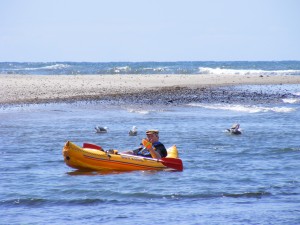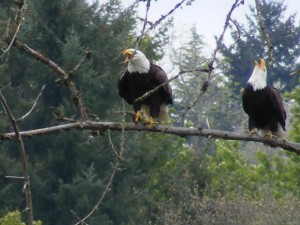Tonight I regret that I finished reading The Elephant Whisperer this morning, because now the book is done, and the adventures are over. Written by Lawrence Anthony, he makes it clear that the communication he had with the elephants was only with the initial generation of the herd that he’d rescued. “I will have no interaction with the new generations. …I only wanted to get Nana the matriarch to trust one human to ease her bitterness over our species as a whole. …Today, when I drive past the herd, Nana and Frankie may still approach me. I will always have that special relationship with them. Nandi, Mabula, Marula and Mandla and of course ET also still know me. …But the youngsters ignore me as I do them. Totally. I am an outsider. The relationships I had with their grandmothers will never be repeated.”* (pp. 367-8)
Anthony passed away nearly two years ago, on March 2, 2012. Following his death, the herd of elephants, led by the matriarchs with whom he’d established communication, reportedly trekked to his home on the Thula Thula reserve in South Africa, in the way elephants might mourn the death of one of their own. His own book, however, attests to the fact that the herd regularly visited his house anyway. Yet it was hearing of this story that prompted me to investigate his life and work.
A touching video about Lawrence Anthony and the herd can be seen at vimeo.com:
(with one spelling error at 18 seconds, where the word should be “conservationist”).
Although my primary concern on this blog is for the Asian elephants and conservation projects for their benefit – because their habitat loss is extremely dire – I am also interested in interspecies communication and extra-sensory abilities among big-brain mammals. So I wanted to find out what Anthony had learned with the African elephants.
His book’s content belies the connotation of its title. Before reading it, the title implied to me that Anthony possessed some psychic or telepathic ability to have mutual communication with the elephants. Of course, this wasn’t the case at all. Anthony spoke aloud to them, and the elephants communicated with stomach rumblings and caresses with their trunks. And sometimes by depositing a pile of dung. Anthony says, “I have long since lost my self-consciousness at chatting away to elephants like some eccentric. As I spoke I looked for signs that something of what I meant was getting across. I needn’t have worried. We had come a long hard road together, this herd and I, and talking to them had been a crucial part of that process. And why not? Who am I to judge what elephants understand or otherwise? Besides I personally find the communication most satisfying. They evidently liked it too, responding with their deep stomach rumblings.” (p. 325)
My impression is that it took months upon months for Anthony to achieve his intimacy with the original herd. It began at the “boma,” a large corral that’s strong enough to hold elephants, where Anthony and a companion spent night and day, for many days, simply being there. After their release into the wild, he continued to interact with them by driving his Land Rover to their location. As I see it, the communication he achieved required three elements: proximity with the herd; persistence; and incredible patience (with the time and freedom in his schedule to permit it). In other words, the vast majority of humans on this planet could never attain or replicate it.
Nevertheless, his insights into elephant communication are valuable. For instance, he learned the rules governing approaching the herd on foot, and crossing the imaginary boundary to enter an individual elephant’s ‘space.’ “Then it dawned,” Anthony says. “As far as the herd was concerned, the boundary was not set in stone. They will reset it – but only when they are good and ready. It has to be their decision. You can’t do it. Only they can.
“From this I also gleaned another important rule in associating with wild elephants, and that is never to approach them directly, but rather put yourself in their vicinity and if they want to, they will come closer to you. If not, forget it: they take their imperial status most seriously.” (192)
Anthony’s goal was to get the herd to tolerate humans nearby, albeit without his style of personal interaction, so that his reserve could conduct walking safaris. Eventually the rangers could walk to within a reasonable distance of the herd without reaction. “Nana had obviously taken her decision and communicated it to the rest of the herd,” Anthony concludes. “And from that I learned another important lesson. Previously traumatized wild elephants appeared to regain a degree of faith in new humans once the matriarch has established trust with just one new human. But it must be the matriarch.” (198)
On one occasion, Anthony recalls, “I was intensely focused on this magnificent creature standing so close to me. All the while Nana kept glancing across or staring at me. Every now and then she would turn her massive body slightly towards me, or move her ears almost imperceptibly in my direction. Her occasional deep rumblings vibrated through my body.
“So this was how she communicated … with her eyes, trunk, stomach rumblings, subtle body movements, and of course her attitude. And then suddenly I got it. She was trying to get through to me – and like an idiot I hadn’t been responding at all!
“I looked pointedly at her and said ‘Thank you’, acknowledging her, testing her reaction. The alien words echoed across the silent veldt. The effect was immediate. She glanced across and held my gaze, drawing me in for several deep seconds, before returning contentedly to her grazing. It was almost as if she was saying, ‘Didn’t you see me, what took you so long?’
“The final piece of the puzzle clicked perfectly into place. While I had been standing there like a robot, she had been prompting me to accept her presence and give some sign that I recognized her. Yet I had been as stiff and rigid as a plank. When I finally acknowledged her, just with a simple ‘thank you’, she instantly responded.
“I had learned something of this before in dealing with some animals, but that ‘Eureka’ moment with Nana really drove it home to me. I had at last grasped that the essence of communicating with any animal, from a pet dog to a wild elephant, is not so much the reach as the acknowledgement. It’s the acknowledgement that does it. In the animal kingdom communication is a two-way flow, just as it is everywhere else. If you are not signaling to them that their communication has arrived with you then there can be no communication. It’s as simple as that.” (194-5)
When Anthony’s reserve received an orphaned, adolescent female elephant – whom they “affectionately named ET, short for ‘enfant terrible,’ terrible child” – he needed his herd to adopt her.
“I called out once I saw them. Three hundred yards away Nana looked up, trunk reaching into the air. A few calls later she sourced the direction of my voice and they all started ambling through the bush towards me. …As they advanced I marveled at this magnificent herd, these beautiful creatures, fat, grey and glowing, and how content they were with new youngsters.
“Now I needed their help. But first I was going to try something in the wilderness I had never done before: get them to follow me.
“…I looked in my rear-view mirror. There were nine elephants following me; I was for a fleeting instant the pachyderm Pied Piper. …Deep in the African bush I had a herd of wild elephants actually following me because I wanted and needed them to. …
“Three miles later we were at the ‘boma.’ Unbelievably, the herd had stayed the course.
“I stopped thirty yards from the fence and Nana came towards me, paused for a moment, and then saw the youngster. She looked back at me, as if, perhaps, to acknowledge why I had called her, then went to the fence and emitted a long set of stomach rumbles.
“ET was as still as a tree, peering at the herd through the dense foliage, lifting her trunk to get their scent. For some moments this continued. Then suddenly, excited as a teenager at a funfair, she came out and ran to where Nana was standing at the fence. These were the first of her own kind she had seen in a year.
“Nana lifted her python-thick trunk over the electric fence, reaching out to ET who responded by raising her own trunk. I watched entranced as Nana touched the troubled youngster who demurely acknowledged the matriarch’s authority. By now the rest of the inquisitive herd had come forward and Frankie, who was also tall enough to get her trunk over the electric strand, did so as well. There they all stood, their stomachs rumbling and grumbling in elephant talk.” (223-4) Within hours, Anthony was able to release ET, and she successfully integrated with the herd.
One of the most poignant episodes with the herd involved a newborn elephant, whom they named Thula, who ultimately didn’t survive. With the help of his staff, Anthony and his wife had taken baby Thula into their home because her front feet were deformed and she could barely stand or walk. Eventually, the herd came to the house to visit, yet there was danger when Anthony perceived that they had caught the scent of Thula. Anthony wanted to communicate that Thula was still alive, yet without triggering the elephants’ uncontrollable maternal instincts. So he took advantage of their olfactory senses. “I went to Thula’s room, took my shirt off and swabbed it over her body, put it back on and wiped my hands and arms all along her. I then walked back down to the fence and called them.
“Nana came over first and as her trunk swept just above the single electric wire in greeting I stretched my hand out as I usually do. The response was remarkable. The tip of her trunk paused at my hand and for an instant she went rigid. Then her trunk twitched as she sucked in every particle of scent. I offered both hands and she snuffled up my shirt and vacuumed every inch. Nandi the mother and Frankie the aunt stood on either side, trunks snaking as they too got the olfactory messages that Thula was alive and close by. …
“Eventually they read whatever they could from my shirt and these three magnificent elephants stood there before me like a judicial panel assessing the evidence.
“After much deliberation they moved off and I could tell that they were relaxed and unconcerned. I’m not saying this lightly as I have seen unhappy elephants. I am familiar with many of their emotions. Whey they left, I know that they were happy. I know that they could have stormed the fence, electric or not, if they had been otherwise. I felt a glow ignite inside me.” (324-5)
Earlier, an arson-set range fire had engulfed the firefighters, including Anthony himself. It is probable that the only reason they survived was due to the elephants’ intervention. As Anthony and his team were fleeing barely ahead of the flames, they found fresh elephant tracks and dung – evidence that they had recently passed the same way, and were nearby. Beginning to panic, Anthony’s companion shouts, “Where to?”
“Then in a flash I realized what we had to do,” Anthony recalls. “Nana had shown the way.
“’Croc Pools!’ I shouted back. ‘If Nana thinks it’s safe enough for the herd it’ll be safe enough for us.’” (184-5) They “waded knee-deep into the pool. The coolness and relief was exquisite.” (185)
“Then it was on us, the heat sizzling and hissing across the water. Yet in that intense theatre I became aware of something transcending the din and fury and chaos. I felt Nana’s stomach rumblings roll across the water, a dominating, calming presence. There she stood, towering over the dam, shielding the babies with her body and spraying water over herself. I found myself doing the same, scooping water over my head as if I had joined the herd. …We had made it, thanks to Nana. She had saved us all.” (186) Later, Anthony states that “we had an elephant to thank for our lives.” (188)
Many chapters of his book contain nothing at all about the elephants; there is also a lot about African culture and other wildlife. At one point, he describes the spiritual and mystical role of the “sangoma,” or diviner, in Zulu society. Anthony implies that the Zulu villagers might have begun to view him as a sangoma, due to his eccentric behavior. “The news of my strange communication with elephants, coupled with my refusal to allow anyone to kill even a deadly snake or scorpion had spread, and many in the village considered me to be somehow mysteriously connected to the animals. I mean, what sort of person would shun normal life and live in the African bush preferring to commune with elephants, rather than his own kind?” (271-2)
Much of the book’s content also discusses the history and background, including extensive meetings with tribal chiefs, that led to the creation of the massive Royal Zulu reserve, which has come to be called The Royal Zulu Biosphere. On the website of The Earth Organization, which Anthony founded, it is described this way: “Another one of Lawrence’s legacies is the creation of a 500 thousand acre game reserve, called The Royal Zulu Biosphere, through a unique partnership between The Earth Organization, six Zulu tribes, and two other game reserves.”(http://www.earthorganization.com/News.aspx?tid=115) This web page also states: “In tribute to our founder who recently passed away, The Earth Organization (TEO) is now operating under the name of the Lawrence Anthony Earth Organization (LAEO).”
Footnote:
* All quotes are from The Elephant Whisperer, copyright © 2009 by Lawrence Anthony and Graham Spence. So I will simply cite the page numbers.

